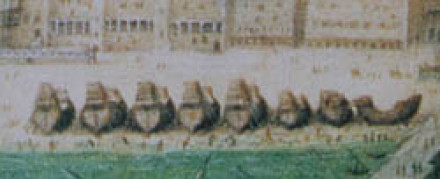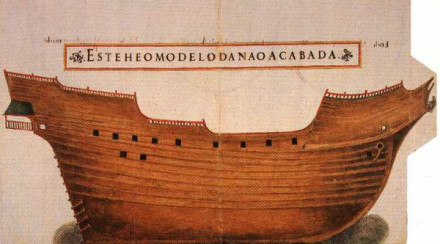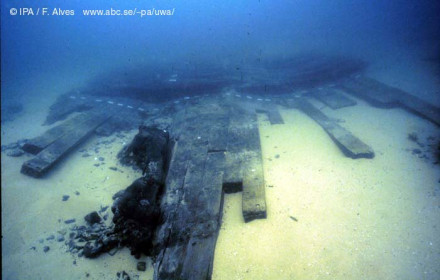History
On September 14th 1606, after a nine months voyage from Cochin, India, and a three month stop in the Azores, the Nossa Senhora dos Mártires arrived in Portugal. A heavy storm forced the drop anchor off Cascais, a small village a few miles from Lisbon. Captain Manuel Barreto Rolim desided to seek shelter in the Tagus estuary. On manouvering to do so the ship sunk in front of the São Julião da Barra fortress in a matter of hours.
Cargo
Her main cargo was pepper. A large amount of pepper was saved and put to dry. The population also salvaged a notable quantity, as it was impossible for the soldiers to stop the locals who, despite the dreadful weather conditions, every night went to the sea in small craft to salvage what they could. During the subsequent summers, the officers of king Felipe III of Spain - who was also king Felipe II of Portugal - may have salvaged a great part of the cargo from the shallow waters, and they certainly rescued cables, anchors and guns.
(source: DANS, and Texas A&M University)

Description
Portuguese East Indiamen. Wrecked at São Julião da Barra in the Tagus. Only a part of the hull remains. Probably the Nau Nossa Senhora dos Mártires.
Keel length: ca 27 m.
Flat amidships: ca 4 m.
Beam: ca 12 m.
Depth in hold: ca 9 m.
39 pre-designed and pre-assembled frames.



Status
The wreck was found in 1993, during an archaeological survey promoted by the
Museu Nacional de Arqueologia under the direction of Dr. Francisco Alves, and
excavated in 1996, 1997, 1999 and 2000. This was one of several wrecks found in
the area in São Julião da Barra at the mouth of the Tagus river, only a few miles off Lisbon.
References
- Pepper wreck Ships lab Texas University.
- Reconstructing a Portuguese India Nau.
- Geneaology and Archaeology of Portuguese Ships at the Dawning of the Modern World.
- Budsberg, N., Jobling, J., and Castro, F. (2016).
Rio Grande do Norte Astrolabe.
International Journal of Historical Archaeology 20.2.
pp 405-421. - Castro, F. (2003).
The Pepper Wreck.
International Journal of Nautical Archaeology, 32.1.
pp 6-23. - Castro, F. (2005).
The Pepper Wreck.
Texas A&M University Press. - Castro, F. (2005).
Rigging the Pepper Wreck. Part I: Masts and Yards.
International Journal of Nautical Archaeology, 34.1.
pp 112-124. - Castro, F. (2009).
Rigging the Pepper Wreck. Part II: Sails.
International Journal of Nautical Archaeology, 38.1.
pp 105-115. - Castro, F. (2013).
Tonnages and displacements in the 16th century.
Journal of Archaeological Science 40.
pp 1136-1143. - Castro, F. and Fonseca, N. (2006).
Sailing the Pepper Wreck: A Proposed Methodology to Understand an Early 17th-Century Portuguese Indiamen.
International Journal of Nautical Archaeology, 35.1.
pp 97-103. - Santos, T., Fonseca, N., Castro, F., and Vacas T. (2012).
Loading and Stability of a Late 16th Century Portuguese Indiamen.
Journal of Archaeological Science 39.
pp 2835-2844.